Pruning trees helps to keep them healthy, shapely, safe, and growing their best. Don’t worry, it’s not that hard. In this post, I am going to show you exactly when and how to trim tree branches yourself, step-by-step.
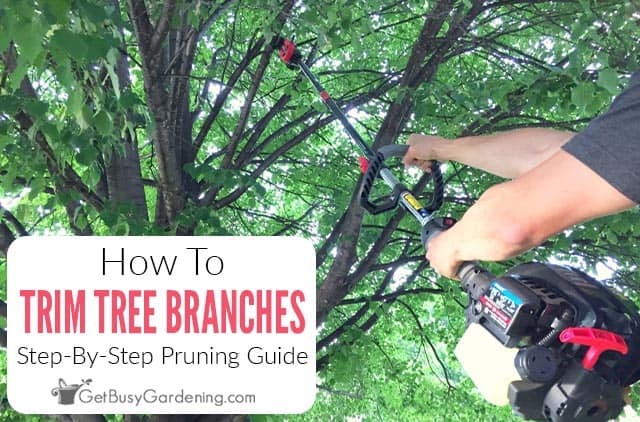
Trimming trees is always a scary topic for newbies (I know it was for me!). In most cases you can easily do it yourself, without worrying about hiring an expensive professional.
There are some proper techniques you need to follow to avoid damaging your tree. But I am going to make this easy for you, and walk you through everything you need to know about how to trim a tree yourself, step-by-step.
Pruning Trees Yourself
Before you get out your tools, it’s a good idea to do a quick online search to look up how to prune the specific type of tree you have to make sure there aren’t any special techniques for it.
Some types (like fruit or flowering trees) prefer to be pruned after they are done blooming, or at other times of the year. Also, most types of evergreens don’t need to be trimmed, except to remove dead or undesirable growth.
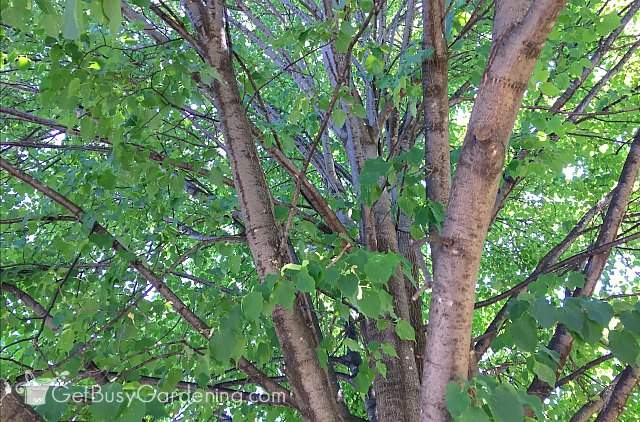
Why Prune Trees?
There are several reasons to prune trees, and it’s a good idea to make it a regular habit to keep them growing their best.
The first time most people think about trimming trees is usually after a storm causes damage, when the lower branches are getting in the way, or when they are posing a hazard of some kind.
Other reasons could be to encourage flowers and fruit production, to trigger new growth, to help prevent disease by allowing better airflow, or simply to shape the tree to make it look nicer.

When To Prune Trees
The ideal time of year to prune trees is during dormancy. So, in general, the best time would be sometime during the winter.
Removing branches during dormancy lowers the risk of disease and pest infestations in the open cut wounds. Pruning before spring also helps to promote healthy and vigorous new growth.
In harsh climates like mine here in Minnesota, it’s best to wait until the coldest winter weather has passed.
So for us, the best time is during the late winter or early spring. In milder climates, you can trim a tree anytime during the winter while it is dormant.
Don’t worry, you can still cut off dead or damaged branches at any time of the year. Just try to avoid doing it on wet, rainy days, or when it’s super humid outside.
Tree Trimming Tools
When it comes to trimming trees, using quality tools is super important. You should always make sure your tools are sharp and clean before you make any cuts.
Dull tools will only damage your trees, and dirty blades could spread disease to the open wounds. Here are the tools I use…
- Pole saw attachment for my trimmer
- Loppers
- Hand pruners
- Safety glasses
Proper Tree Pruning Techniques
Improper pruning can lead to disease or pest problems. So before you start, it’s important to understand exactly how to trim a tree.
When branches are removed properly, the wounds will callus over making a nice thick circle all the way around the cut.
It’s important for the callus to form correctly to protect the tree from problems down the road, like rot caused by water pooling in the wound.
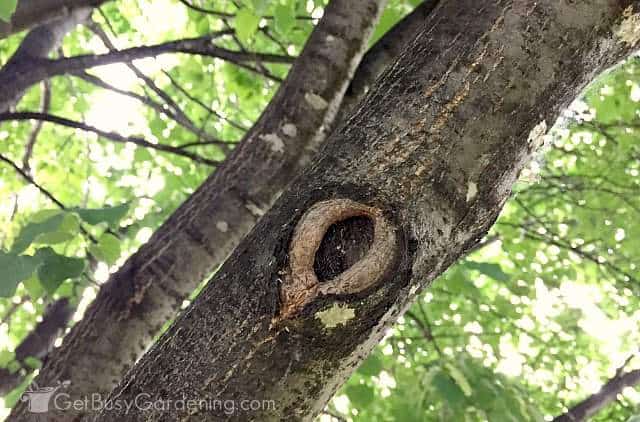
Here are tips for how to trim tree branches properly…
1. Locate the branch collar before cutting – Once you decide which limb you’re going to remove, the first thing to do is locate the branch collar.
This is the area where the branch is coming out of the tree. It’s easier to see on some than it is on others – but look for a ridge, a circle, or an area where the bark is thicker.
It’s important to make the cut on the outside of the branch collar, so the wound can heal properly. Also, be sure not to damage the branch collar, or it won’t be able to form a good callus (which can cause rotting later on).
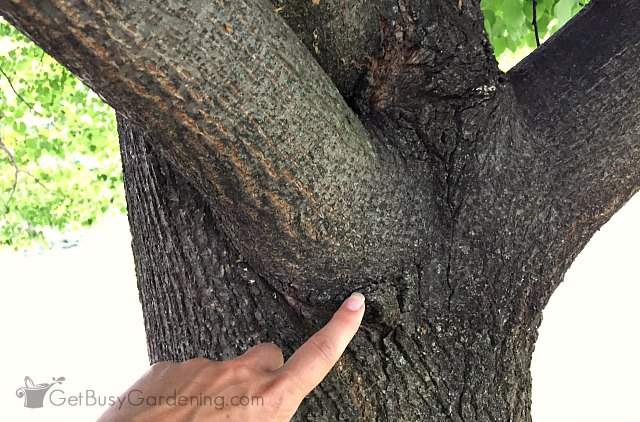
2. Make your cuts at a downward angle – As you trim the tree, it’s important to make your cuts at a downward angle.
This is so that water can’t settle into the wound. If water gets into the wound consistently, it could eventually cause rotting.
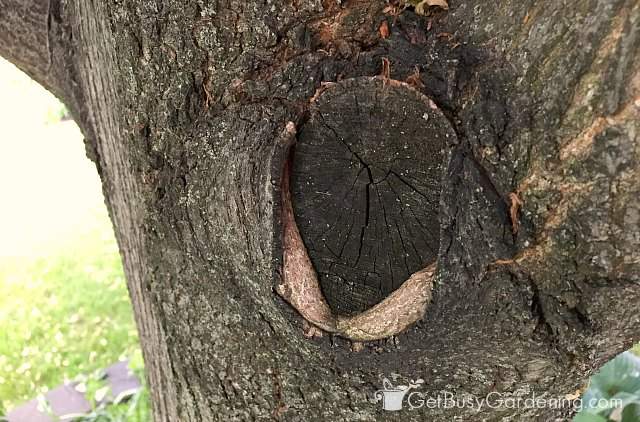
3. Never trim branches that are growing upward – When you’re first learning how to trim a tree, a common mistake is to remove the branches that are growing straight up.
But if you prune those, it will leave a wound where water can easily settle, which can cause the tree to rot over time.
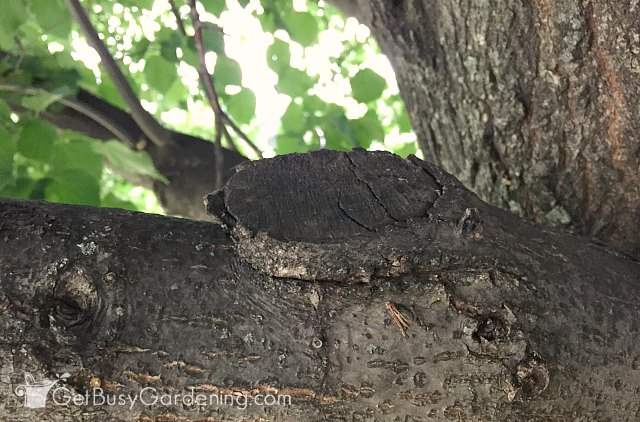
4. Don’t prune a branch too long – You should also take care that you’re not leaving too long of a stub when removing the branches.
Leaving too long of a stub will also make it difficult for the tree to form a proper callus around the wound.
Related Post: How To Cut Grass Like A Pro Using Lawn Mowing Patterns & Techniques
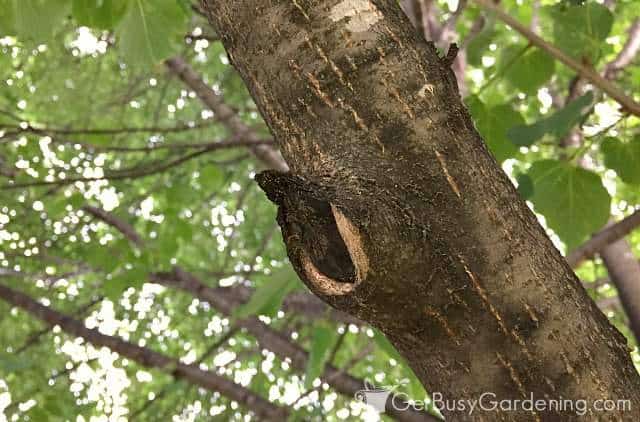
How To Trim A Tree Step-By-Step
Now that you know the proper techniques for how to trim a tree, let’s talk about the steps to follow while pruning them.
But a word of caution before getting started. Never, never try pruning your own trees if they are anywhere near power lines. It’s best to just let the pros handle that!
Here’s a quick list of the steps, and then the more detailed steps are below.
- Trim off any suckers growing at the base of the trunk
- Remove all the dead or dying branches
- Prune out unwanted or hazardous branches
- Remove any damaged or weak branches
- Trim out overlapping branches that rub together
Step 1: Pruning suckers – Suckers are weak, weedy looking growth that forms at the base of the trunk.
These suckers will never become desirable branches, and only steal energy from the tree. So, be sure to get rid of any suckers as you see them forming.
Step 2: Remove dead or dying branches – Cutting off the dead branches is the best place to start, and will make the rest of the steps easier too.
Once you have removed all of the dead branches, it’s easier to see what you’re working with, and spot the ones that need to be pruned next.
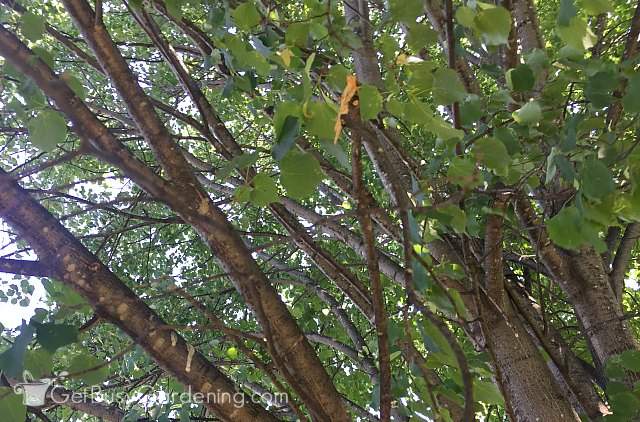
Step 3: Prune out unwanted or hazardous branches – Branches that are hanging low, touching your house, or are causing some kind of a safety hazard can be trimmed next.
Most of the time the goal here is just to raise the height of the canopy, or get rid of an obstruction. This can usually be done by trimming small branches, rather than removing an entire limb.
Step 4: Remove damaged and weak branches – Tree branches that have been damaged in a storm, or are otherwise broken or weakened should be cut off even if they are still alive.
They are an invitation for pests and disease, could become hazardous, and can also be a place where water settles.
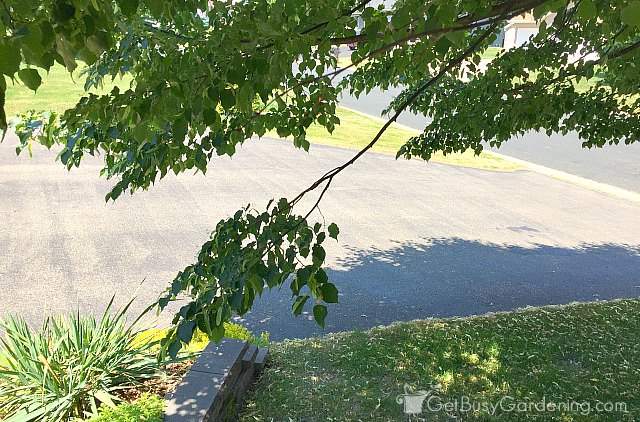
Step 5: Trim out crossing branches – Now that you’ve got most of the tree cleaned up, it’ll be easy to spot branches that are overlapping and rubbing against each other. When they rub together, they can damage each other over time.
Remove both branches if they are both damaged. Otherwise either cut off the damaged one, or the smallest of the two.
More Tree Trimming Advice & Pruning Tips
- As you’re just learning how to a trim tree yourself, the best thing to do is to start small, and work your way into it slowly. Don’t overdo it! Start with one or two of the steps above, and then wait until next year for the rest.
- Be careful when removing large limbs. This can be risky to the health of a tree. It’s best to leave them unless there’s a good reason to get rid of them, like if they are dead, damaged, diseased, or causing some kind of hazard.
- As you’re pruning, remember to take a step back now and then to look at the tree from all angles, and check the shape. It’s easy to get carried away with cutting branches, only to realize the tree looks lopsided after you step out from underneath it.
- Never trim off more that 1/4 of the living tree branches at one time. If you need to remove more than that, do some of it this year, and then wait to do the rest over the next few years.
FAQs
Below I will answer some of the most frequently asked questions about trimming trees. If you can’t find your answer here, then ask it in the comments below.
Can you kill a tree by cutting branches?
Yes, you can kill a tree by over pruning it. It’s best to start small, and only remove a few branches at a time. Then every year, continue working on it until you reach the desired shape.
Also, don’t cut off any large limbs unless they are dead or severely damaged. Cutting off large limbs could end up killing the tree.
Does pruning hurt trees?
If done properly, pruning does not hurt the tree, it’s actually quite beneficial. But, if you’ve never done it before, it’s best to start small, and work your way into it. You don’t want to go overboard, and cut off too many branches.
If you’re nervous that you’ll overdo it, just start by getting rid of any dead or damaged branches this year. Then wait until next year to remove any others that need to be trimmed.
Now that you understand how to trim tree branches yourself, it’s a good idea to get into the habit of doing it on a regular basis. That way, your trees will be healthy, safe, and looking their best!
More Pruning Guides
- Pruning Plants: The Complete Guide
- How To Prune Hydrangeas
- How To Prune Russian Sage
- How To Prune Roses
Share your tips for how to trim trees in the comments section below!
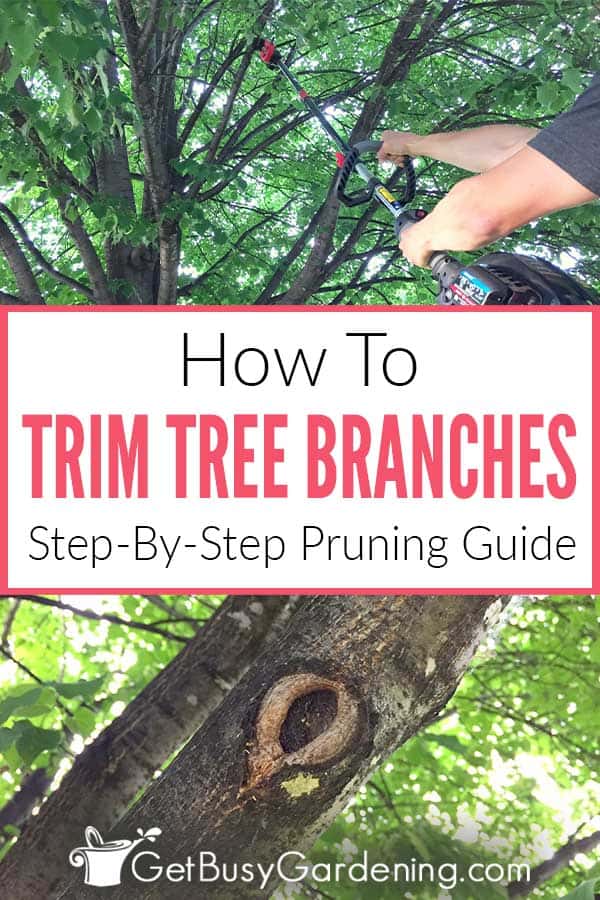
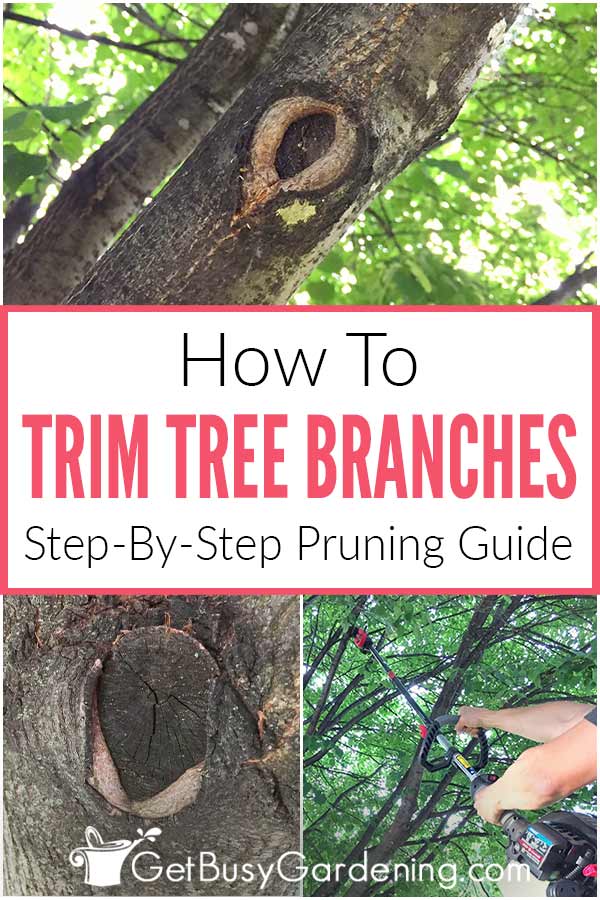
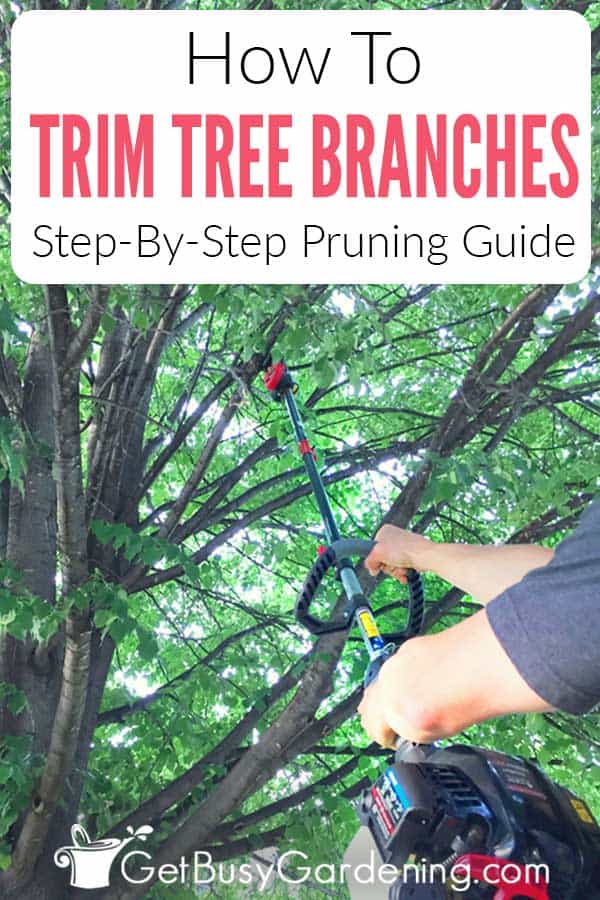

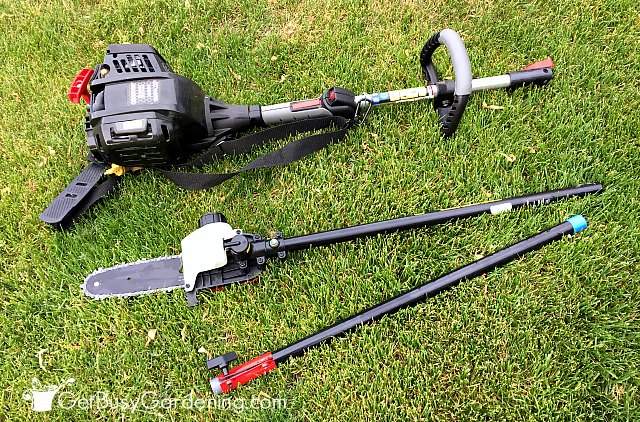

Nancy says
Hi, you state to prune when tree is dormant, does this mean I should wait for all the leaves to fall before pruning? If so, any suggestions on how to tell best places to prune?
Amy Andrychowicz says
Yes, the best time to prune trees most types of trees is in the winter or very early spring while they are dormant and it’s cool outside.
Marilyn Heese says
I have a 3 year old silver rimmed maple. Rough growing but healthy now. It has 2 large trees growing out if the base. One about 5′ the other about 6-1/2′. Is it unhealthy to let both grow or should I just stick w one? If I have to cut the small one, how do I do it. It will have to be a horizontal cut.
Thx
Amy Andrychowicz says
The growth at the bottom are called suckers, and you definitely need to prune them off or they can steal energy from the tree. Trim them back as close to the base/main trunk as you can, and make the cuts at a downward angle to prevent water from pooling in the wound.
Emily says
You said to not cut branches that are growing straight up for fear of water pooling, however I have a tree that has a few dead looking branches at the top that are growing straight up and need to be taken down. What would you suggest in this situation?
Amy Andrychowicz says
Cut those tree branches at a downward angle. That way the water will run off, and won’t be able to pool in the wound.
Tom Baker says
Is it wise to thin out a tree to make it less liable to be blown over by strong winds?
Amy Andrychowicz says
Sure, if that’s a concern.
Rebecca says
You said to leave the large limbs if possible, but there is just this one really long limb on one side near the top looking awkward and making too much weight on that side. It’s healthy and it’s the biggest limb on the whole tree. I wish I could just shorten it! What do I do?
Amy Andrychowicz says
I do not recommend removing the largest limb, or your tree may not recover from that hard of a pruning. Instead, you could try trimming it back to make it shorter. But, if you just got done pruning the tree, then you might want to give it one more growing season to see how well it fills in. When done properly, the other branches/limbs will fill in to even it out.
Karolina Murray says
Hi
I was wondering about my massive fig tree. And some other trees with similar state where some branches look almost dead but then they have a few leaves at the end of the branch. The fig tree even grow fruit on these deadlike branches. Can I cut these down? I feel that my fig tree is getting way to big and tangled.
Thanks for a great article!
Amy Andrychowicz says
Unfortunately, I don’t have an article about pruning fruit trees. It’s a good idea to research exactly how to trim each specific tree that you have, in order to make sure you’re doing it correctly. Especially when it comes to fruiting or flowering trees.
Barbara Bullis says
I have a large Autumn purple ash. It’s long limbs are getting too much for the tree. If like to cut a few of these long limbs back at least half way. Where do I chose a place to cut? Before or after the place where the limb branches out ( not sure what it’s called, the place where two twigs come out off either side of the limb.)
Amy Andrychowicz says
You should trim the branches on your tree back to the place right after the limb branches out.
Terry Bridgeman says
Is there a different rule for time of pruning for evergreen and deciduous trees?
Amy Andrychowicz says
Nope. Late winter/early spring (while the tree is still dormant) is the best time for pruning all types of trees.
Henry Davis says
on trimming tree branches on the main trunks do you cut the hair like little branches growing off of it or leave it
Amy Andrychowicz says
Yes, you can trim off those tiny branches if you’d like. If they are low on the trunk, then they are suckers, and definitely need to be removed from the tree.
Norman Fuehner says
On my tree I have many small limbs close to the bottom! And they are aproblem when I cut the grass,
do I need to trim them every year are what should I do to stop the groth of the lower limbs? I live in Missouri.
Amy Andrychowicz says
You can’t stop the growth of new limbs on your tree, but you certainly can prune it every year to keep the lower branches out of your mowing path.
Richard P. Charlton says
Half of my Rose of Sharon Bush has dead branches. The bush is about 25 years old; 8ft high and 8ft wide. Should I cut the branches now or remove the whole bush from its roots?
I would greatly appreciate your advice.
Amy Andrychowicz says
You can prune out the dead branches at any time. That would be my first step. Then wait until after it’s done blooming to prune it for size and shape.
John R. Graham says
Another option is to use a electric pole saw. Starting is never an issue; with a sharp chain you will have similar results. I have never used sealer, having found that a proper “collared” cut works well and is more natural. Good basic article makes for a good refresher! Many people are hesitant to prune or they will over prune…go slow and be careful.
Amy Andrychowicz says
Thanks for your added tips about trimming trees!
sheryl says
What do you put on the cut limbs to keep bugs and disease away?
Amy Andrychowicz says
I don’t put anything on the wounds. I have read that some experts recommend putting some kind of tree sealer on the cut in climates where pests and disease are a major problem. But, one of the main reasons to be sure to trim tree branches during the winter is to avoid issues with pests and disease. That way, the tree will have time to heal before bugs/disease come out of dormancy.